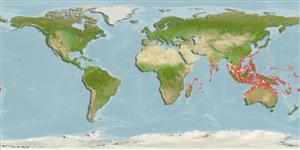Actinopterygii (ray-finned fishes) >
Perciformes (Perch-likes) >
Serranidae (Sea basses: groupers and fairy basslets) > Epinephelinae
Etymology: Epinephelus: Greek, epinephelos = cloudy (Ref. 45335).
Environment / Climate / Range
Ecology
Marine; brackish; reef-associated; depth range 20 - 60 m (Ref. 89707). Tropical, preferred ?; 36°N - 27°S, 31°E - 179°W (Ref. 5222)
Indo-West Pacific: East Africa to the Ryukyu Islands, Marshall Islands, Fiji, New Caledonia, and northern Australia. Recently recorded from Tonga (Ref. 53797). Reported from Somalia and India by Heemstra & Randall in 1984 but valid records and specimens have not been found (Ref. 4787). Closely related to Epinephelus summana known only from the Red Sea.
Length at first maturity / Size / Weight / Age
Maturity: Lm ?, range 16 - ? cm
Max length : 40.0 cm TL male/unsexed; (Ref. 27362)
Dorsal
spines
(total): 11;
Dorsal
soft rays
(total): 14-16;
Anal
spines: 3;
Anal
soft rays: 8. Distinguished by the following characteristics: juveniles black with white polka dots become numerous, smaller, and coalesce to form a pattern of wavy lines on the sides with growth (Ref. 37816); ctenoid scales on body except cycloid anteriorly above lateral line, thorax and abdomen; body with auxiliary scales; greatest depth of body 2.8-3.2 in SL; rounded caudal fin; short pelvic fins, 1.9-2.4 in head length (Ref. 90102); head length 2.3-2.5 times in SL; head pointed, flat interorbital area, dorsal head profile slightly convex; rounded preopercle, serrae small and mostly covered by skin; strongly convex upper edge of operculum, rear edge almost vertical, upper spine extending posterior to lower spine; posterior nostril diameter about twice that the anterior nostril; maxilla reaches to or slightly vertical at rear edge of eye; small, embedded scales on maxilla; 2-4 rows of small teeth at midlateral part of lower jaw; canines at front of jaws small or absent (Ref. 89707).
Inhabits inner coastal and lagoon reefs, also in brackish waters where it occurs in ledges and caves (Ref. 5213). Feeds on crustaceans and small fishes (Ref. 89707). Adults usually in 20+ m depth (Ref. 48635). Solitary (Ref 90102).
Life cycle and mating behavior
Maturity | Reproduction | Spawning | Eggs | Fecundity | Larvae
Heemstra, P.C. and J.E. Randall, 1993. FAO Species Catalogue. Vol. 16. Groupers of the world (family Serranidae, subfamily Epinephelinae). An annotated and illustrated catalogue of the grouper, rockcod, hind, coral grouper and lyretail species known to date. Rome: FAO. FAO Fish. Synop. 125(16):382 p. (Ref. 5222)
IUCN Red List Status (Ref. 115185)
CITES (Ref. 94142)
Not Evaluated
Threat to humans
Harmless
Human uses
Fisheries: minor commercial
More information
ReferencesAquacultureAquaculture profileStrainsGeneticsAllele frequenciesHeritabilityDiseasesProcessingMass conversion
Tools
Special reports
Download XML
Internet sources
